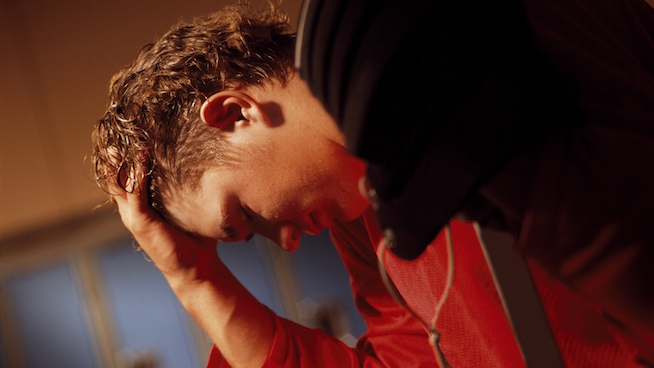Does Lactic Acid Really Make You Sore?
We’ve all experienced it: the ache that “hurts so good” on that last set of Squats or that spreads throughout your muscles on the final sprint to the finish.
If you walk into most gyms and ask what’s the reason would be for this, a majority of the population would throw lactic acid under the bus. Ask the same group why they’ll dread walking down stairs for three days after leg day, and “lactic acid buildup” will be to blame. And the best way to beat that feeling? Hopping on a stationary bike to “flush out the lactic acid,” of course. But is lactic acid really the main culprit for the pain and soreness we associate with exercise?
First of all, let’s get an understanding of what lactic acid is and where it comes from (get ready for your biochemistry lesson.)
As we exercise, our bodies require fuel sources to drive the intensity of our workout. High intensity workouts of a short duration result in anaerobic metabolism, whereas long-term exercise is primarily aerobic in nature. One of these metabolic processes is called glycolysis, or in layman terms, the breakdown of glucose. Through a series of reactions, we convert glucose (or glycogen) into adenosine triphosphate (ATP); an extremely valuable energy source for muscle contractions and other cells in the body. But as the body generates ATP, it also produces other byproducts. Hydrogen ions (H+) are one of these byproducts (from a molecule called NADH), and when your body’s demand for oxygen outweighs the amount it can take in (as is the case during intense exercise), pyruvic acid will take on the H+ ions to produce lactic acid.
Upon the formation of lactic acid, it quickly ionizes (aka removing a H+ ion), and results in lactate formation. So in the end, most of the conversation about “lactic acid” is in reality a debate regarding lactate. Cue the mic drop.
So what if I told you that this whole “lactic acid” situation potentially served some good? First of all, lactic acid formation helps recycle NAD, which allows for the glycolytic reactions to continue. More glycolysis means more ATP. More ATP means more energy. Boom. Another reason is that lactic acid can be converted back into glucose, and is used as fuel by the heart and skeletal muscles. Take that as food for thought (pun intended).
What about the muscle soreness argument? Well unfortunately, you can no longer curse out lactic acid for the post leg day waddle that occurs 24-48 hours after your squats. At least not if you want to be scientifically accurate.
Why not? Blood lactate levels return to normal resting levels within an hour of exercise, so the fact that it causes soreness so far beyond the end of exercise is not likely. Delayed onset muscle soreness is rather the result of microscopic tearing of muscle and connective tissue, predominately from eccentric contractions.
Still convinced lactic acid is the enemy? Then this part is for you. While our body typically does a good job buffering lactic acid (and H+ ions), there comes a point during higher-intensity training where the rate of accumulation of lactic acid becomes too much. This point is known as the lactate threshold, and typically occurs around ~60% of one’s VO2 max (depending on training status). Once this threshold has been reached, the body begins breathing heavier as more CO2 is being produced (aka the ventilatory breakpoint), and fatigue onset is typically soon to follow. This threshold is key for endurance athletes, and in fact is a better indicator of performance than VO2 max. So what can you do about it?
Lactate threshold training involves performing workouts at higher intensities with the intention of improving your body’s ability to utilize lactate as a fuel source. These workouts can be interval based, higher volume, or sustained levels of near maximal intensity, and typically involve working at a given percentage of your maximal heart rate. Incorporate a few of these workouts into your routine and you’ll be well on your way to crushing your endurance goals.
RELATED: 5 Brutal Drills to Push Your Lactic Threshold
Long story short, think twice before you place the blame on lactic acid during your next workout. It’s not at fault when you can’t raise your arms up after your burnout set of Curls, and you can thank it later for the energy it’s giving your old ticker. So spread the word, and the next time you hear lactic acid being thoughtlessly blamed for pain or soreness, drop some knowledge.
Photo Credit: Constantinis/iStock
RECOMMENDED FOR YOU
Does Lactic Acid Really Make You Sore?
We’ve all experienced it: the ache that “hurts so good” on that last set of Squats or that spreads throughout your muscles on the final sprint to the finish.
If you walk into most gyms and ask what’s the reason would be for this, a majority of the population would throw lactic acid under the bus. Ask the same group why they’ll dread walking down stairs for three days after leg day, and “lactic acid buildup” will be to blame. And the best way to beat that feeling? Hopping on a stationary bike to “flush out the lactic acid,” of course. But is lactic acid really the main culprit for the pain and soreness we associate with exercise?
First of all, let’s get an understanding of what lactic acid is and where it comes from (get ready for your biochemistry lesson.)
As we exercise, our bodies require fuel sources to drive the intensity of our workout. High intensity workouts of a short duration result in anaerobic metabolism, whereas long-term exercise is primarily aerobic in nature. One of these metabolic processes is called glycolysis, or in layman terms, the breakdown of glucose. Through a series of reactions, we convert glucose (or glycogen) into adenosine triphosphate (ATP); an extremely valuable energy source for muscle contractions and other cells in the body. But as the body generates ATP, it also produces other byproducts. Hydrogen ions (H+) are one of these byproducts (from a molecule called NADH), and when your body’s demand for oxygen outweighs the amount it can take in (as is the case during intense exercise), pyruvic acid will take on the H+ ions to produce lactic acid.
Upon the formation of lactic acid, it quickly ionizes (aka removing a H+ ion), and results in lactate formation. So in the end, most of the conversation about “lactic acid” is in reality a debate regarding lactate. Cue the mic drop.
So what if I told you that this whole “lactic acid” situation potentially served some good? First of all, lactic acid formation helps recycle NAD, which allows for the glycolytic reactions to continue. More glycolysis means more ATP. More ATP means more energy. Boom. Another reason is that lactic acid can be converted back into glucose, and is used as fuel by the heart and skeletal muscles. Take that as food for thought (pun intended).
What about the muscle soreness argument? Well unfortunately, you can no longer curse out lactic acid for the post leg day waddle that occurs 24-48 hours after your squats. At least not if you want to be scientifically accurate.
Why not? Blood lactate levels return to normal resting levels within an hour of exercise, so the fact that it causes soreness so far beyond the end of exercise is not likely. Delayed onset muscle soreness is rather the result of microscopic tearing of muscle and connective tissue, predominately from eccentric contractions.
Still convinced lactic acid is the enemy? Then this part is for you. While our body typically does a good job buffering lactic acid (and H+ ions), there comes a point during higher-intensity training where the rate of accumulation of lactic acid becomes too much. This point is known as the lactate threshold, and typically occurs around ~60% of one’s VO2 max (depending on training status). Once this threshold has been reached, the body begins breathing heavier as more CO2 is being produced (aka the ventilatory breakpoint), and fatigue onset is typically soon to follow. This threshold is key for endurance athletes, and in fact is a better indicator of performance than VO2 max. So what can you do about it?
Lactate threshold training involves performing workouts at higher intensities with the intention of improving your body’s ability to utilize lactate as a fuel source. These workouts can be interval based, higher volume, or sustained levels of near maximal intensity, and typically involve working at a given percentage of your maximal heart rate. Incorporate a few of these workouts into your routine and you’ll be well on your way to crushing your endurance goals.
RELATED: 5 Brutal Drills to Push Your Lactic Threshold
Long story short, think twice before you place the blame on lactic acid during your next workout. It’s not at fault when you can’t raise your arms up after your burnout set of Curls, and you can thank it later for the energy it’s giving your old ticker. So spread the word, and the next time you hear lactic acid being thoughtlessly blamed for pain or soreness, drop some knowledge.
Photo Credit: Constantinis/iStock










